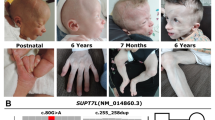Abstract.
The RecQ helicases belong to the Superfamily II group of DNA helicases, and are defined by amino acid motifs that show sequence similarity to the catalytic domain of Escherichia coli RecQ. RecQ helicases have crucial roles in the maintenance of genome stability. In humans, there are five RecQ helicases and deficiencies in three of them cause genetic disorders characterised by cancer predisposition, premature aging and/or developmental abnormalities. RecQ helicase-deficient cells exhibit aberrant genetic recombination and/or DNA replication, which result in chromosomal instability and a decreased potential for proliferation. Here, we review the current knowledge of the molecular genetics of RecQ helicases, focusing on the human RecQ helicase disorders and mouse models of these conditions.
Similar content being viewed by others
Author information
Authors and Affiliations
Corresponding author
Additional information
Received 9 March 2007; received after revision 26 April 2007; accepted 2 May 2007
Rights and permissions
About this article
Cite this article
Hanada, K., Hickson, I.D. Molecular genetics of RecQ helicase disorders. Cell. Mol. Life Sci. 64, 2306–2322 (2007). https://doi.org/10.1007/s00018-007-7121-z
Published:
Issue Date:
DOI: https://doi.org/10.1007/s00018-007-7121-z




